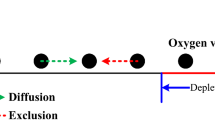Abstract
The electrical resistance of gas sensors, based on polycrystalline metal-oxide semiconductors, obeys a power-law response with the pressure of different gases (R ~ pγ). The exponent γ can be derived resorting to the mass action law and its value depends on chemical reactions that take place at the surface of the grains. To explain the gas sensitivity, we revisit two conceptual models, regularly used in the literature: the ionosorption and the vacancy models. We show that they predict different values for the exponent γ. Also, the consequences of considering the bulk oxygen vacancies as deep levels are analyzed. Comparison of γ values obtained from both conceptual models with those found in experiments can indicate what mechanisms are possible to occur.


Similar content being viewed by others
Availability of data and material
Data sharing not applicable to this article as no datasets were generated or analysed during the current study.
Code availability
Not applicable.
References
D.R. Miller, S.A. Akbar, Sens. Actuators B: Chem. 204, 250–272 (2014)
I.D. Kim, A. Rothschild, H.L. Tuller, Acta Mater. 61, 974–1000 (2013)
W.T. Moon, Y.K. Jun, H.S. Kim, W.S. Kim, S.H. Hong, J. Electroceram. 23, 196–199 (2009)
S. Mahajan, S. Jagtap, Appl. Mater. Today. 18, 100483 (2020)
N. Barsan, U. Weimar, J. Electroceram. 7, 143–167 (2001)
A. Gurlo, Chem. Phys. Chem. 7, 2041–2052 (2006)
A. Gurlo, R. Riedel, Angew. Chem. Int. Ed. 46, 3826–3848 (2007)
S. Kucharski, P. Ferrer, F. Venturini, G. Held, A.S. Walton, C. Byrne, J.A. Covington, S.K. Ayyala, A.Q.M. Beale, C. Blackman, Chem. Sci. 13, 6089–6097 (2022)
P. Mars, D.W. van Krevelen, Chem. Eng. Sci. 3, 41–59 (1954)
C. Doornkamp, V. Ponec, J. Mol. Catal. A: Chem. 162, 19–32 (2000)
N. Yamazoe, K. Shimanoe, Sens. Actuators B: Chem. 128, 566–573 (2008)
G. Eranna, B.C. Joshi, D.P. Runthala, R.P. Gupta, Crit. Rev. Solid State Mater. Sci. 29, 111–188 (2004)
N. Yamazoe, K. Suematsu, K. Shimanoe, Sens. Actuators B: Chem. 176, 443–452 (2013)
N. Yamazoe, J. Fuchigami, M. Kishikawa, T. Seiyama, Surf. Sci. 86, 335–344 (1979)
K.V. Sopiha, O.I. Maliyi, C. Persson, P. Wu Appl. Mater. Interfaces 13, 33664–33676 (2021)
T. Wolkenstein, Electronic Processes on Semiconductor Surfaces during Chemisorption (Consultants Bureau, New York, 1991)
P.M. Desimone, F. Schipani, R. Procaccini, D.A. Mirabella, C.M. Aldao, Sens. Actuators B: Chem. 370, 132387 (2022)
N. Yamazoe, K. Suematsu, K. Shimanoe, Sens. Actuators B: Chem. 163, 128–135 (2012)
N. Ma, K. Suematsu, M. Yuasa, T. Kida, K. Shimanoe, A.C.S. Appl, Mater. Interfaces 7, 5863–5869 (2015)
P. Shankar, J.B.B. Rayappan, Sci. Lett. J. 2015 4, 126 (2014)
M. Habgood, N. Harrison, Sur. Sci. 602(5), 1072–1079 (2008)
C. Blackman, ACS Sensors 6, 3509–3516 (2021)
M. Eslamian, A. Salehi, E. Nadimi, Surf. Sci. 708, 121817 (2021)
J.N. Zemel, Thin Solid Films 163, 189–202 (1988)
S. Kucharski, C. Blackman, Chemosensors 9, 270 (2021)
J. Ding, T.J. McAvoy, R.E. Cavicchi, S. Semancik, Sens. Actuators B: Chem. 77, 597–613 (2001)
L. Zhao, X. Gong, W. Tao, T. Wang, P. Sun, F. Liu, X. Liang, F. Liu, Y. Wang, G. Lu, ACS Sensors 7, 1095–1104 (2022)
S. Samson, C.G. Fonstad, J. Appl. Phys. 44, 4618–4621 (1973)
J. Maier, W. Göpel, J. Solid State Chem. 72, 293–302 (1988)
K.G. Godinho, A. Walsh, G.W. Watson, J. Phys. Chem. C 113, 439–448 (2009)
A.K. Singh, A. Janotti, M. Scheffler, C.G. Van de Walle, Phys. Rev. Lett. 101, 055502 (2008)
S. Lany, A. Zakutayev, T.O. Mason, J.F. Wager, K.R. Poeppelmeier, J.D. Perkins, Phys. Rev. Lett. 108, 016802 (2012)
C. Kilic, A. Zunger, Phys. Rev. Lett. 88, 095501 (2002)
M.A. Kozhushner, L.I. Trakhtenberg, V.L. Bodneva, T.V. Belisheva, A.C. Landerville, I.I. Oleynik, J. Phys. Chem. C 118, 11440–11444 (2014)
Acknowledgements
This work was partially supported by the National Council for Scientific and Technical Research (CONICET) of Argentina, and the National University of Mar del Plata (Argentina). C.M.A. acknowledges invaluable discussions with Professor Chris Blackman.
Funding
This work was partially supported by the National Council for Scientific and Technical Research (CONICET) of Argentina and the National University of Mar del Plata (Argentina).
Author information
Authors and Affiliations
Contributions
Conceptualization, D.A. Mirabella, P.M. Desimone, and C.M. Aldao; investigation, D.A. Mirabella, P.M. Desimone, and C.M. Aldao, writing original draft preparation D.A. Mirabella and C.M. Aldao; writing review and editing, D.A. Mirabella, P.M. Desimone, and C.M. Aldao; funding acquisition, C.M. Aldao. All authors have read and approved the final manuscript.
Corresponding author
Ethics declarations
Conflic of interest
The authors declare they have no financial interests.
Additional information
Publisher's Note
Springer Nature remains neutral with regard to jurisdictional claims in published maps and institutional affiliations.
Rights and permissions
Springer Nature or its licensor (e.g. a society or other partner) holds exclusive rights to this article under a publishing agreement with the author(s) or other rightsholder(s); author self-archiving of the accepted manuscript version of this article is solely governed by the terms of such publishing agreement and applicable law.
About this article
Cite this article
Mirabella, D.A., Desimone, P.M. & Aldao, C.M. On the mass action law and the power law response in tin dioxide gas sensors. J Electroceram (2024). https://doi.org/10.1007/s10832-024-00351-3
Received:
Accepted:
Published:
DOI: https://doi.org/10.1007/s10832-024-00351-3



